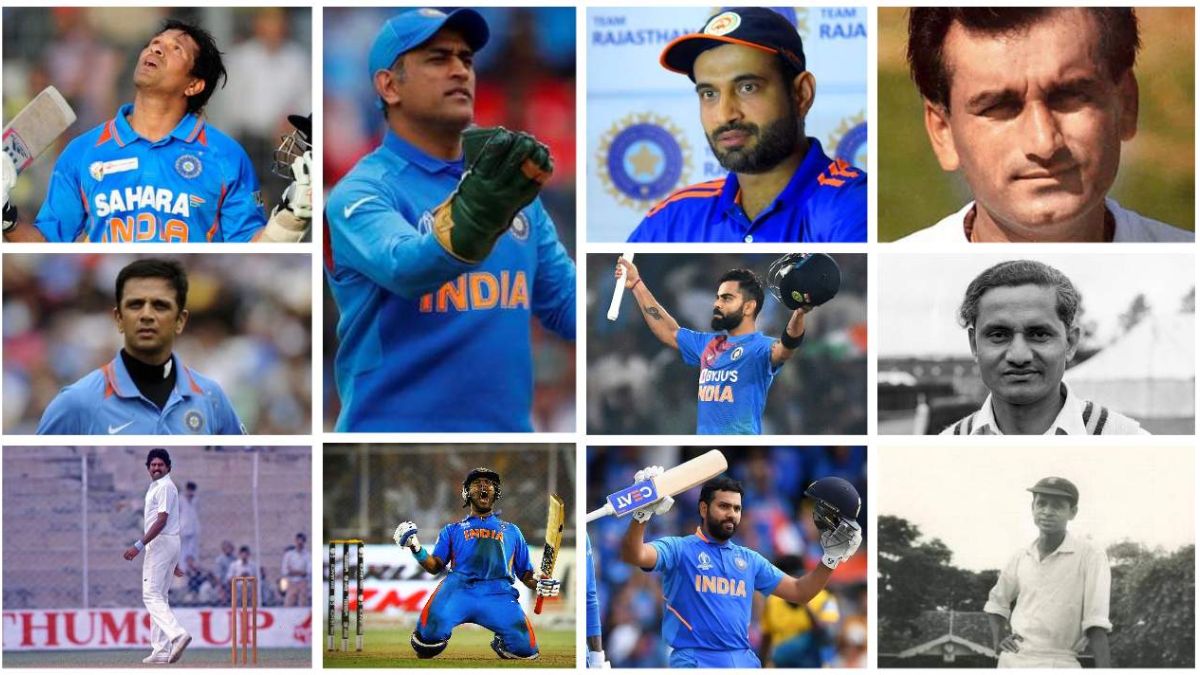India’s history on the international cricket scene is as rich as it is colorful. A country that regards its national game as something religious has a passion for cricket like no other nation in the world.
India’s time at the top of the game is much more recent, with the nation only taking part in its first Test in 1932.
Let us review the most famous cricketers with their brief records here.
1. Sunil Gavaskar
Career Span: 1971-1987
Tests: 125
Runs: 10,122
Batting Average: 51.12
Undoubtedly, the greatest opening batsman of all time, Sunil Gavaskar was India’s first true bat-handling great. The right-hander, his country’s third-top goal scorer, possessed the most classic technique, only enhanced by his incredible mental toughness. Gavaskar’s defense was considered nearly impenetrable, making his wicket one of the most valuable scalps in the world. The 64-year-old was also a pioneer of professionalism in Indian football, his work ethic and dedication helped set new standards for Indian players internationally. Certainly, much of India’s recent success can be traced to Gavaskar’s unprecedented influence 40 years ago. Read More: National record holder triple jumper Aishwarya Babu banned for 4 years for doping
2. Virendra Sehwag
Career Span: 2001-2013
Tests: 103
Runs: 8,503
Batting Average: 49.43
While Gavaskar stands as perhaps the best starter of all time, Virender Sehwag is undoubtedly the most destructive.
In his most fluid form, Sehwag can wreck an opponent’s bowling attack in under an hour, such is the devastation caused by his vicious stroke play. No player in the history of Test cricket has accumulated runs at the same rate as Sehwag.
His highest score of 319 was achieved in just 304 deliveries, while two of his other five 200+ scores came faster than one run per ball. Although his technique, which involves minimal footwork, can leave him touchy at times, his unmatched aggression and penchant for pushing the envelope have made Sehwag the most destructive Test racquet of all time.
3. Rahul Dravid
Career Span: 1996-2012
Tests: 163
Runs: 13,265
Batting Average: 52.63
Rahul Dravid was given the nickname “The Wall”.
The owner of a virtually unbreachable defense, Dravid became a prolific run scorer, known for spending hours at the crease, often batting India’s opponents out of the game.
Dravid, of course, never possessed the swashbuckling tendencies of Sehwag nor the classic flourish of Gavaskar, but his powers of concentration oversaw his rise to the pinnacle of the game.
His run tally is the second-greatest mark in his nation’s history, and so too is his collection of 36 Test hundreds.
The right-hander’s 180 against Australia in Kolkata in 2001 will forever be remembered as one of the world’s cricket’s defining innings, while his 233 against the same opponent in Adelaide in 2003 delivered India their first victory Down Under in 22 years.
4. Sachin Tendulkar
Career Span: 1989-2013
Tests: 198
Runs: 15,837
Batting Average: 53.86
The obvious choice for this team, Sachin Tendulkar’s career in India extended beyond sport; a small example that perfectly illustrates India’s seismic transformation into a world power. Since his Test performance in 1989 at the age of just 16, Tendulkar has been an international phenomenon, a man forced to live up to the expectations of a nation of billions. Better technology could not be dreamed of. The perfect lateral position, impeccable balance, and delightful swing of the cane made Tendulkar seem like he was watching Mozart in action. A slight twist of the wrists sends the ball through the center of the goal, and a graceful step forward burns the red leather unstoppably through the shield. However, it is Tendulkar’s drive that is perhaps cricket’s most iconic shot, a prime example of the best batsman. So simple yet imposing, Tendulkar is undoubtedly the greatest of all who represent India.
5. Vijay Hazare
Career Span: 1946-1953
Tests: 30
Runs: 2,192
Batting Average: 47.65
Relatively unknown among the younger generation of cricketers, Vijay Hazare was one of the first Indian players to achieve significant international success. Before his arrival, Indian batsmen reluctantly played against the world’s best teams, who were regularly humiliated outside the subcontinent. Hazare was one of the first to change that. His stubborn approach and enormous stamina made the right-footed batsman extremely persistent.in Adelaide against a famous Australian team in 1948, Hazare amassed two hundred including 145 in the second set when six of his teammates failed to score. Hazare also once had the highest score among the Indians when they scored 164 runs in a winless match against England in Delhi in 1951. Had it not been for World War II, the international price of Hazare would no doubt have been even higher.
6. MS Dhoni
Career Span: 2005-2013
Tests: 77
Runs: 4,209
Batting Average: 39.70
Dismissals: 248
MS Dhoni, arguably India’s most influential wicketkeeper, sits comfortably in his country’s top XI. Dhoni, who rose to the India national team from disadvantaged background, came onto the international stage with a swagger and confidence, unlike previous Indian players. With this mindset, Dhoni made an immediate impact at the test level, and his unconventional yet destructive ways quickly gained worldwide notoriety. The 32-year-old has also emerged as an immensely respected leader of the national team, whose captaincy has led India to one of their most successful times in the game. With

7. Kapil Dev
Career Span: 1978-1994
Tests: 131
Runs: 5,248
Batting Average: 31.05
Wickets: 434
Bowling Average: 29.64
Not only is he the greatest fast bowler in his country’s history, but Kapil Dev is also the best all-rounder to ever represent India. Although his position in the game at the international level was somewhat diminished by playing in the same era as Sir Ian Botham, Sir Richard Hadlee, and Imran Khan, Dev beat Gavaskar and Tendulkar for the honor of the 20th-century Indian cricketer. An incredibly disciplined player, Dev could move the ball both ways in the air, mostly away from right-handers. His haul of 500 wickets was once the best in world cricket. Kapil Dev could also hit in style, however, his unobtrusive style produced more than 5,000 runs in a glittering 16-year career.
8. Anil Kumble
Career Span: 1990-2008
Tests: 132
Wickets: 619
Bowling Average: 29.65
A true warrior of Indian cricket, Anil Kumble defied conventional wisdom to become his nation’s most prolific wicket-taker. While Kumble’s raw ability was somewhat limited, his will and determination carried the bowler, who broke his leg, to a national record 619 Test wickets. Faster than traditional leg spinners, Anil Kumble used his unusual pace to regularly fool hitters who were often unsure how to play his unorthodox pitches. Subtle variations in flight and spin increase his threat, though a slippery straight turf used to be his main ball. Anil Kumble may never have been the most exciting cricketer, but his heart and dedication made him an indispensable member of the Indian team for nearly two decades.
9. Virat Kohli
Career Span: 2011-till date
Tests: 107
Runs: 8230
Batting Average: 48.12
India has given the world great cricketers, but none as ambitious as Virat Kohli. To achieve his ambitions, Kohli capitalized on the technical diligence and fitness of Sachin Tendulkar, who was in the league of the best athletes in the world, not just the cricketer.
As a result, Kohli became the most consistent accumulator of any format of his time, making dizzying chases easy and, in his own words, finding the surest way to score. Many of them. That ambition passed smoothly to his captaincy: demanding more than ever of his bowlers, especially the faster ones, often sacrificing a batsman for bowling depth and resulting in India staying long at the top.1 in the test ranking and first series win in Australia. He is on course to become India’s most successful Test captain.
Apart from one in Bangladesh, Kohli has scored hundreds of runs in Tests and against every nation, he has played for. He ruthlessly broke records for the number of games played, scoring eight, nine, ten, and eleven ODI runs. He was a real threat to Sachin Tendulkar’s record of 49 ODIs and 51 Test hundred.
Under-19 World Cup captain Kohli was a precocious talent with a will to kill from cover as he burst onto the scene. He was destined to become India’s next big batsman as the Tendulkar era began to end. But Kohli aspired to be more – a cricketer whom opponents would admire, a cricketer whose presence would heighten the intensity of the competition. He lived every ball, kicked every moment, and made sure he had the fitness and strength to do it. He has been widely credited with changing the fitness culture in Indian cricket by introducing endurance tests as a selection criterion. Kohli was simply India’s most powerful captain. He has been at the center of every Indian cricket marketing campaign. Even spearheading it at a time when the BCCI was run by interim administrators who knew how not to incur the ire of India’s biggest cricket star. There was never any reason to doubt his intentions – to do things that would bring victory to India, which abounded under his rule.
10. Javagal Srinath
Career Span: 1991-2002
Tests: 67
Wickets: 236
Bowling Average: 30.49
While the 1990s were dominated by spin in India, Javagal Srinath shone as the pre-eminent Indian bowler of the decade. Big, strong, and aggressive, Srinath braved slow, lifeless pitches across the subcontinent to trouble players with his impressive pace and rebounds. When conditions weren’t right, however, Srinath could also use the old ball to great effect, extracting movement from the back seam for a length to tease even the best in the world. Although Srinath’s durability and stamina were arguably his greatest weakness, as an Indian pacesetter he was only behind Kapil Dev for wickets when he retired in 2002.










